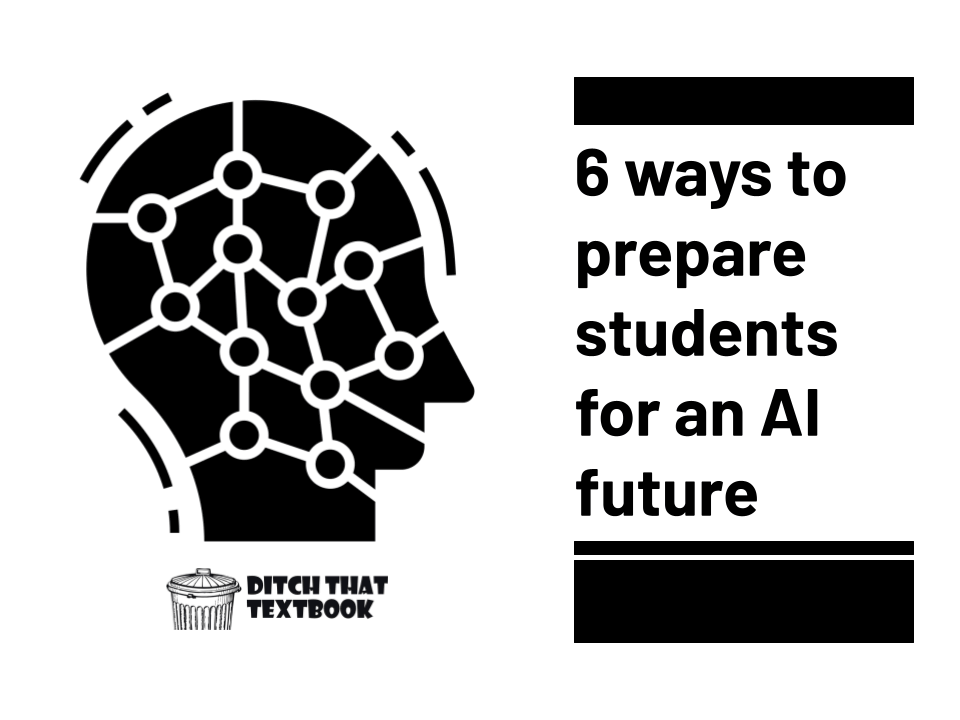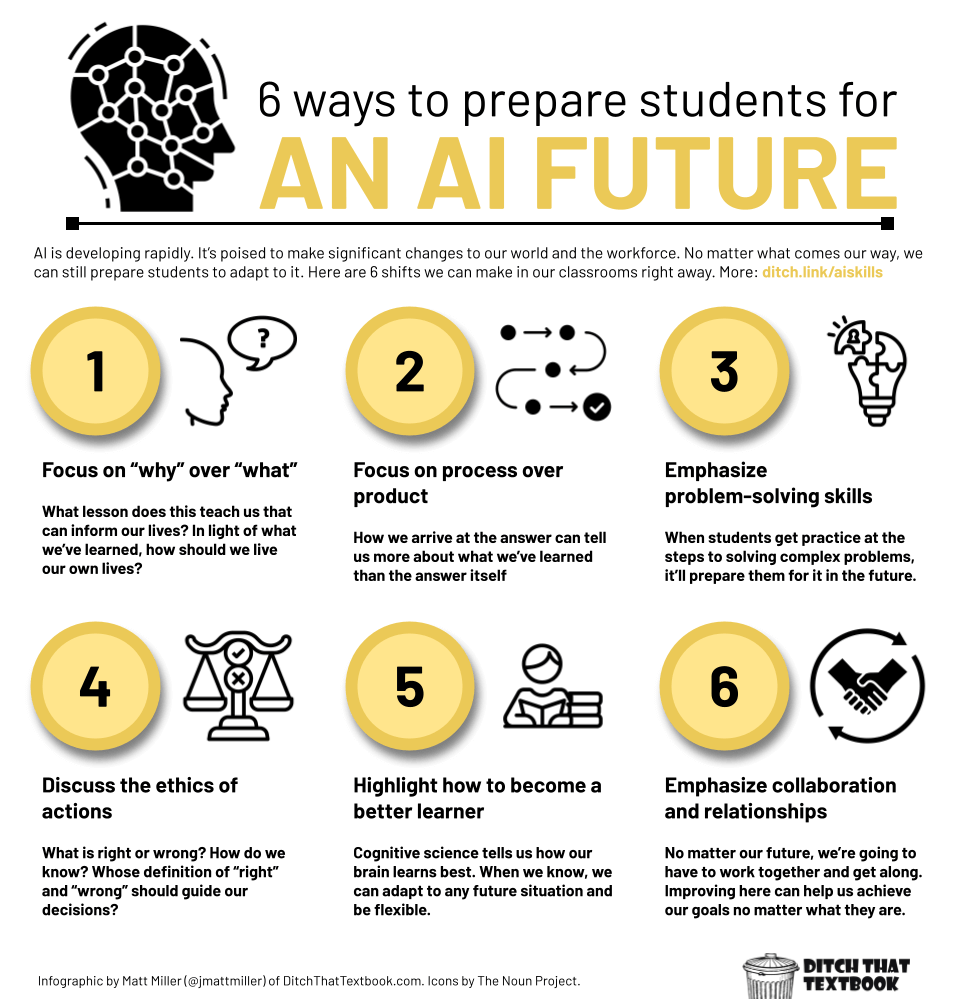
AI is developing rapidly. It’s poised to make significant changes to our world and the workforce. No matter what comes our way, we can still prepare students to adapt to it. Here are 6 shifts we can make in our classrooms right away.
Artificial intelligence has been growing by leaps and bounds.
Some of us look at it and think about today. "How can this help me plan my lessons?" "How can AI help me cut my grading time in half?"
And we should. We should be thinking about AI can help us today.
But some of us are thinking farther into the future. We're wondering where all of this is heading and how we can help prepare students for this future where AI changes many things. (Maybe everything?)
We're asking questions like: "What can I do today to help prepare students for 10 years in the future?" "Is what they're learning in my class relevant to their future lives?"
Let's be honest. Most of us can't make significant changes in our schools or school districts by ourselves.
But we can make small shifts in the way we teach -- starting today.
Let's look at six shifts we can make in our classes today to prepare students for that future.
Spoiler alert: None of these have to do with using more AI in class.
Why are these shifts important?
Advancements in artificial intelligence are coming at breakneck speeds.
In just one year, OpenAI released ChatGPT and ...
- they released an upgraded AI model (GPT-4)
- they added "computer vision," the ability to interpret images
- they created Code Interpreter, an AI model to process and generate programming code
- they gave ChatGPT a voice -- and let you interact back and forth with your voice
And that's just one AI product. In just a year's time, dozens -- if not hundreds -- of new AI-driven tech tools have emerged.
Why is this important? Because as AI improves, it'll create a seismic shift in the workforce, in how we do work, and in how we live our lives.
So, where are we headed?
In a survey of 352 machine learning researchers, here's where these researchers thought AI would change the world and the workforce:
- AI will outperform humans in many activities in the next 10 years
- It will drive trucks by 2027
- It will work in retail by 2031
- It will write a bestselling book by 2049
- It will work as a surgeon by 2053
Here's the catch. This study was published in 2018, years before the boom in AI we've seen recently. These predictions happened before the increase in funding and public interest in AI.
Interestingly, these researchers also thought AI would be translating languages by 2024 and writing high-school essays by 2026. Looks like we're already outpacing those predictions.
Why is this important? Because the workforce our current students will enter in just a few years may be drastically different than it is today.
This isn't just saying "it'll be different for them than it was for me." It's more like "it'll be different than life is today."
How can we prepare students for this AI future?
For one, schools need to start having discussions -- sometimes tough discussions -- about AI and about the direction they're heading and how they're preparing students for their future.
Many districts have begun drafting policies about appropriate, responsible use of artificial intelligence on the classroom, school, and district levels.
But we don't need systemic change to start preparing students for a future where AI is prominent.
A few small shifts in the classroom can make a world of difference.
Bonus: Some of these shifts will sound familiar -- and they're shifts you may have already made.


1. Focus on "why" over "what"
Traditional teaching is hyper-focused on answering the "what" question over the "why" question.
It's the focus of multiple-choice quizzes and tests. It's written into the comprehension questions at the end of textbook chapters. You see it in movie depictions when the teacher asks the whole class questions, no one answers, and the teacher desperately asks, "Anyone? Anyone?"
Thankfully, lots of great teachers aspire to more than that. But even so, the emphasis on "what" is still ever-present.
Instead, let's make a small shift in the direction of "why."
What this means: Facts and details are only a small part of the full story. And many times, they're not instructive. They don't teach us life lessons that can guide our decision-making in the future.
Plus ... (and I know I don't have to tell you this) ... with search engines and AI assistants to help us look these details up, the value in being able to recall them isn't as strong.
A focus on the "why" is about the lessons learned. The path we can take with our own lives. The advice and truths we can carry with us when it's time for us to make our own decisions.
How this prepares us for an AI future: Just as search engines did, the growth of AI assistants will make information easier to access. The more accessible it is, the more we can ask this question -- "What can I DO with that information?" AI models will be able to gather, summarize, and prioritize information for us. It's still up to us to make decisions -- to take action in our lives. These "why" conversations can inform that.
Prompts you can use in class:
- Why do you think they did that?
- How did that turn out for them?
- If you were in their shoes, how would you do that differently?
- How does this translate to our everyday lives?
- How could this have informed something that's going on in the world today?

2. Focus on process over product
Many times with schoolwork, we assign grades based on what students have turned in to us. We look at worksheets, essays, math equations, science problems. If they get the answer right, they get the points.
Here's the problem, though. In the real world, there are lots of places where getting the right answer EVENTUALLY is just as beneficial as getting the answer right the first time.
When we focus on process over product, we help students focus on the "why" and the "how" so they can apply those lessons to other areas of their lives.
What this means: Process over product puts more of the emphasis on how you got to the product than the actual product itself. It helps the student -- and the teacher -- look at the steps and the thought process.
Instead of completing the entire math worksheet, maybe a student does a deep dive on one individual problem -- and records themselves talking through the entire process in video or audio.
Reflection questions can be really helpful here, too. Encourage students to describe their process in follow-up questions. When they do that, they're forced to confront how they arrived at their conclusions. Plus, you -- the teacher -- have a glimpse into the way your students think.
How this prepares us for an AI future: Much like the "why over what" above, process over product helps us focus on student thinking. In the past, we have used worksheets and essays to gauge what students think, how much they've learned, what they're able to do. But when artificial intelligence can create those artifacts of learning, it's up to the human to focus on the process. Sure, AI will be able to help us solve problems. But as humans, there will always be situations where we'll need to take action on our own.
Prompts you can use in class:
- How do you solve that?
- Tell me about the steps you took to arrive at that conclusion.
- What was a part of the process that was tricky for you?
- How did you get through any struggles that you had?
- If you did it all over again, how would you do this differently?
- What did you learn through the process that you'd do again?

3. Emphasize problem-solving skills
There are lots of ways to solve a problem. But if you haven't solved many complex problems in your life -- or if you haven't stopped to think about the process -- the way to solve problems might not seem immediately clear.
But if you're able to work methodically through a problem to come to a solution? That's something we'll have to do on our feet -- on the fly -- for the rest of our lives, no matter how much AI can assist us.
What this means: Problem solving is more than answering questions. It also doesn't have to be as complex as adopting a problem-based or project-based learning approach in your classroom. It can land somewhere in the middle.
There are lots of approaches to solving complex problems. This eight-step process for solving problems includes:
- Defining the problem
- Clarifying the problem
- Defining the goals
- Identifying the root cause of the problem
- Developing an action plan
- Executing the action plan
- Evaluating the results
- Continuously improving
How this prepares us for an AI future: AI models are getting better and better at taking complex problems -- with a variety of information -- and providing solutions. However, the priorities and values that go into the problem-solving process don't always match up with what we want as humans. Plus, we won't always be in a place where it'll make sense to consult an AI model for solutions to problems. We'll need to solve problems on our own.
Prompts you can use in class:
- What do you think the problem is -- and can we all agree on it?
- What do we want to achieve? What is our goal?
- Which actions are the best to help us achieve our goal?
- How do we take those actions?
- Do the results show that we successfully solved the problem -- or showed success in some places?
- How could we do this differently to improve next time?

4. Discuss the ethics of actions
Decisions are messy. Even when it seems like there are very few options, asking which option is best can be a loaded question. Sometimes our decisions impact some people more than others. Sometimes they have positive and negative effects. Some decisions could be seen as wrong by certain people and right by others.
This is the heart of ethics. Should we take this course of action? Which course of action should we take? And why?
Important ethical decisions will need to be made by the humans -- and not the AI models -- as AI establishes a stronghold in our world. We will need humans who grasp the gravity of those decisions -- and can take action that benefits us all. They'll need practice, and we can provide a start.
What this means: Ethics can be defined as the philosophical study of moral right and wrong, good and bad, and the rules and principles that should govern human conduct. Morally right and wrong decisions have been made throughout history. Plus, in all fields of study, ethics guide what we do and don't do.
As we make a shift from "what" to "why" (see above), asking ethical questions can help students practice making decisions and "getting it right."
How this prepares us for an AI future: AI models make decisions based on their training and the data in their datasets. Where did that data come from ... and who shapes their training? Humans ... at least for now. Artificial intelligence is still in its infancy. It will continue to proliferate across the workforce and our everyday lives. But how much should it? And in what areas? And in what ways? We don't want to farm these decisions out to artificial intelligence because they'll impact how we exist and what future we have. If we help create ethical thinkers in the classroom, our students will be better equipped to make these decisions in the future.
Prompts you can use in class:
- Is that course of action good or bad? Why?
- Who would see this as positive -- and who would see it as negative? Why?
- Who would this decision impact the most -- and in positive or negative ways?
- What (or who) is influencing the decision making -- and in what ways?
- What are the short-term and long-term consequences of these actions?

5. Highlight how to become a better learner
Throughout their careers in education, our students do a lot of learning. They do activities that help them to learn. But rarely do they get to understand the science of learning -- what's going on in their brains, how it works, and how it can be done better. Hopefully, they have trained educators who are making conscious decisions that help them learn effectively. But when they understand how the brain learns best, they're equipped with skills that will prepare them to adapt to anything in their future.
What this means: Cognitive science has studied how the brain works, how people interpret and process information, and how they improve at skills. Plenty of effort in the field for decades has focused on memory -- how to remember things. As we go forward, this will still be important -- but other areas of learning will be crucial as well. The Derek Bok Center for Teaching and Learning at Harvard University shares these areas in the science of learning:
- How memory works
- Comprehending and communicating knowledge
- Metacognition and motivation
- Promoting engagement
How this prepares us for an AI future: It's impossible to know how the world and the workforce will change as AI becomes more widespread. It's safe to say that some jobs will become obsolete while other new jobs will be created. (There's also an argument to be made about the place of jobs and work in a world of AI models with far superior intellect. But that's a conversation for another day.) No matter the changes that happen in this world, if we know how to learn effectively -- and make decisions and solve problems based on it (see above) -- we'll be better prepared for the coming world that changes quickly. Agile learners will have an advantage in an ever-changing AI world.
Prompts you can use in class:
- What can we do to understand this more clearly?
- What are the ways that you learn best?
- What does research tell us is an effective way for us to learn?
- Under what circumstances do you learn best?

6. Emphasize collaboration and relationships
The world of work and our personal worlds have always thrived on working together and building relationships with each other. People still make the world go round. Companies have continually built upon this philosophy. In the 2023 NACE Job Outlook survey, "ability to work in a team" ranked second in attributes that employers seek on a candidate's resume. Sixty-one percent of respondents in the survey attributed "ability to work in a team" as very important or extremely important. (First place: problem-solving skills. See No. 3 above!)
Collaboration and relationship-building can provide motivation for students in work. But it can also prepare them for the future work world -- in whatever shape or form they find it.
What this means: Collaborative work, in its truest form, means that students work together and depend on each other's unique skills to come to a conclusion (or product) that couldn't be reached without everyone's efforts. Even if we don't reach this pinnacle, efforts to collaborate can help students see each other's unique viewpoints. They can help students see mistakes and work through them effectively. Plus, they can help students to do more -- and work better -- than they might on their own.
Building relationships is a skill that prepares students for the future. No matter our future, there will always be humans, and we humans will need to get along with each other. We will still depend on each other. If students get practice in building relationships -- even working relationships with classmates they don't see eye to eye with -- they're getting practice at that crucial skill.
How this prepares us for an AI future: The growth of AI will change the way we do work. But it won't mean that humans don't exist anymore. Even if AI is able to complete tasks for us and do some of the thinking, humans will still do important work -- and will need a purpose. We will still crave human-to-human interaction no matter what. The ability to work together with one another -- and the ability to get along with each other -- seems to be a timeless skill.
Prompts you can use in class:
- What was the distribution of work like in this project -- and what did you think of it?
- What skills and abilities did you bring to the project?
- Were your strengths best utilized in this project -- and if not, how could that have changed?
- Were there any confrontations or disagreements -- and how were they handled?
- What steps can you take to set your interactions with your teammates up for success?


Wonderful resources
Fantastic post! Great info to help start and/or deepen the tough discussions. Thanks, Matt!